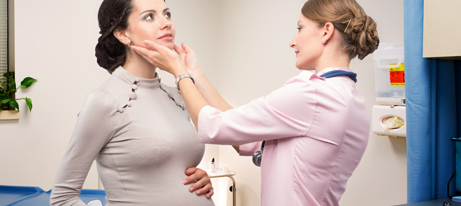
IuriiSokolov/Getty Images
Testing most women for subclinical hypothyroidism in the first trimester of pregnancy may contribute to overdiagnosis and overtreatment of this condition during and after pregnancy. Researchers concluded this after studying thyroid-stimulating hormone (TSH) testing patterns in nearly 190,000 women. Treatment and monitoring of minor TSH elevations that otherwise spontaneously resolve can lead to unnecessary costs, Lois Donovan MD, FRCPC, an endocrinologist at the Cumming School of Medicine, University of Calgary, and the study’s senior author, told CLN Stat.
Subclinical hypothyroidism TSH goes by a number of definitions, such as >2.5 mIU/L or >4.0 mIU/L. The necessity of testing for TSH early in pregnancy has generated some controversy. In clinical practice, Donovan’s team had observed that minor TSH elevations in early pregnancy often resolved without intervention. Other studies have failed to show the benefit of treating women with levothyroxine for minor TSH elevations. “There is a paucity of data about the routine clinical practice of thyroid testing and patterns for initiation of thyroid hormone therapy during pregnancy and its continuation post partum,” wrote the study’s authors.
The retrospective cohort study of pregnancies in Alberta, Canada, looked at frequency and distribution of TSH testing by gestational age, TSH measurement values associated with starting therapy, and the frequency of therapy that continued after pregnancy. Investigators defined the subclinical hypothyroidism as TSH of 4.01 to 9.99 mIU/L and overt hypothyroidism as TSH ≥10.00 mIU/L.
The study included 188,490 women without thyroid disease. Investigators examined delivery records, physician billings, and pharmacy and laboratory administrative data, calculating the proportion of pregnancies with thyroid testing and frequency of each thyroid test. Testing generally took place during the 5th or 6th week of gestation, and therapy was administered around 7 weeks.
Among the pregnancies studied, nearly 60% had at least one TSH measurement. Investigators noticed that thyroid hormone therapy for subclinical hypothyroidism (TSH 4.01–9.99 mIU/L) often took place after just one measurement, even though TSH in this range often normalized on its own. In all, >5,000, or 4.5%, of women who were tested started on thyroid hormone therapy. Most of these patients received levothyroxine, and nearly half continued with the treatment postpartum. About a third received two or more prescriptions in the first year after giving birth.
Donovan’s team concluded that:
- TSH screening often takes place very early in pregnancy, at just 5 or 6 weeks gestation.
- It is not appropriate to apply a TSH reference range established at 9 to 12 weeks gestation to TSH values obtained earlier in pregnancy.
- It is well established that TSH rapidly drops in the first trimester due to normal physiological changes. Therefore, applying a TSH reference range established at a later gestational timing in the first trimester to a TSH sample collected earlier in the first trimester can lead to overdiagnosis of subclinical hypothyroidism in pregnancy.
“This raises concerns about overmedicalization during pregnancy, given that minor, untreated TSH elevation usually normalized, as indicated by repeat measurement,” wrote the study authors. The frequency with which women continued their therapy after pregnancy is especially concerning, they continued. “Although these factors may be contributing to the overmedicalization of pregnancy, a small proportion of women (1.5%) had overt hypothyroidism that would have required treatment.”
These findings suggest that current practice patterns need to change, starting with evidence-based clinical practice guidelines that delineate when TSH testing should take place in pregnancy and when thyroid treatment should continue following pregnancy.